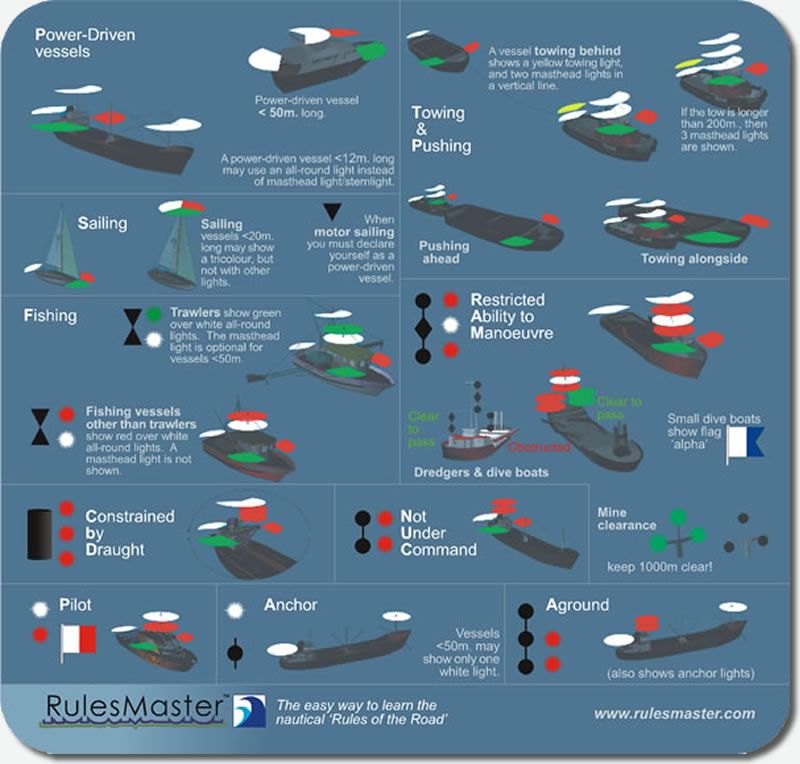Guide to marine navigation lights
A guide to marine navigation lights is an attempt to simplify the numerous lighting requirements yachts have as well as to explain and interpret the lights on other vessels. This article is mainly focussed on yacht owners like myself with yachts over 7 meters but no larger than 50 meters (one can dream…).
It is important to note that lighting requirements on boats are based on state legislation. So if you need to, consult your local rules and regulations. If you are wandering the seas as we do, these guidelines below will take you a long way in understanding your own requirements as well as recognising lights on other boats that you come across in your travels. Most of the guidelines set out below are based on the International Regulations for Preventing Collisions at Sea. Most of the jurisdictions around the world would have adopted these rules and regulation if not fully, to a large degree.
Why do we need lights on boats?
First and foremost we need lights to be seen by other boats. Not just at night but also under adverse conditions such as heavy rain, mist and fog.
Therefore, navigation lights must be shown on your yacht:
- between sunset and sunrise, and
- in restricted visibility.
Navigation lights do much more than just making your position known to other boaters. A combination of the position of the lights on your yacht and their colour also indicates:
- the size of your yacht,
- the angle your yacht is facing,
- the direction your yacht is travelling, and
- if your yacht is underway or anchored.
So let us have a look at our own navigation lights. What goes where if you like… Let’s assume you fit in the demographic I pointed out earlier which is your average cruising yacht.
The starboard sidelight
This light is green and on most yachts is mounted somewhere on the bow rail. It’s light projects directly forward on one perimeter to 112.5-degree to starboard at the other.
The port sidelight
This light is red and on most yachts is mounted somewhere on the bow rail opposite the starboard sidelight. It’s light projects directly forward on one perimeter to 112.5-degrees to port at the other.
The stern light
This light is white and is normally mounted somewhere on the stern of the yacht such as the transom. It’s light projects backwards with one perimeter to 67.5-degrees port and at the other to 67.5-degrees starboard.
Sailboats less than 20m in length may combine sidelights and stern lights in a single lantern tri-colour light carried at the top of the mast.
These lights must be on when under sail. When motoring, an additional masthead light must be shown. This is a forward-facing white light that gives the same angle of light as the red and green sidelights. It must be mounted no less than 2 meters above the deck and is usually mounted halfway up the mast.
The last compulsory light is the mooring light or anchor light. It is also a white light but must be an all-round light visible from any angle. It needs to be on when anchored or moored between sunset and sunrise or in restricted visibility. This light is normally mounted at the top of the mast.
For ocean-going yachts, all these lights should be visible at 3 Nm although 2 Nm is permissible. This rating is printed on the packaging.
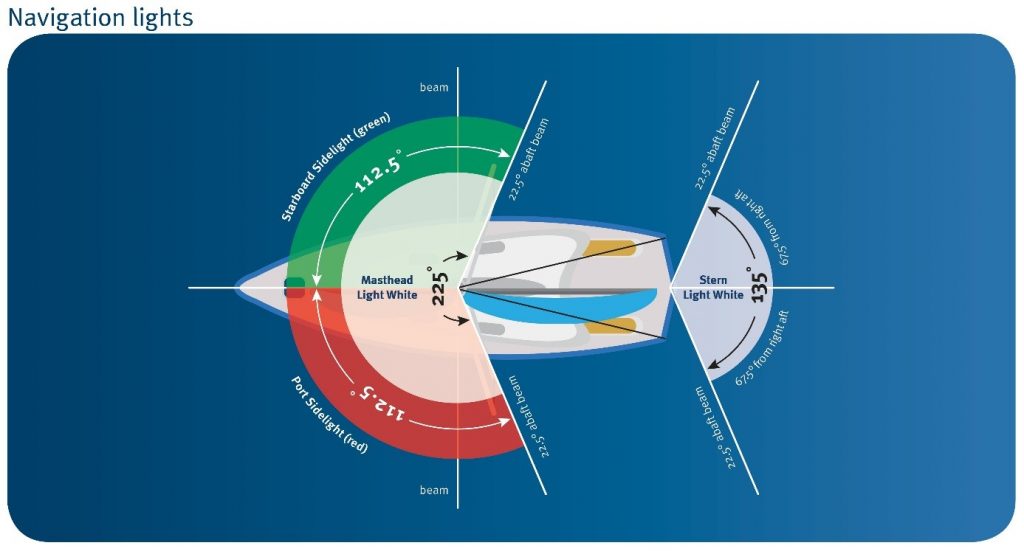
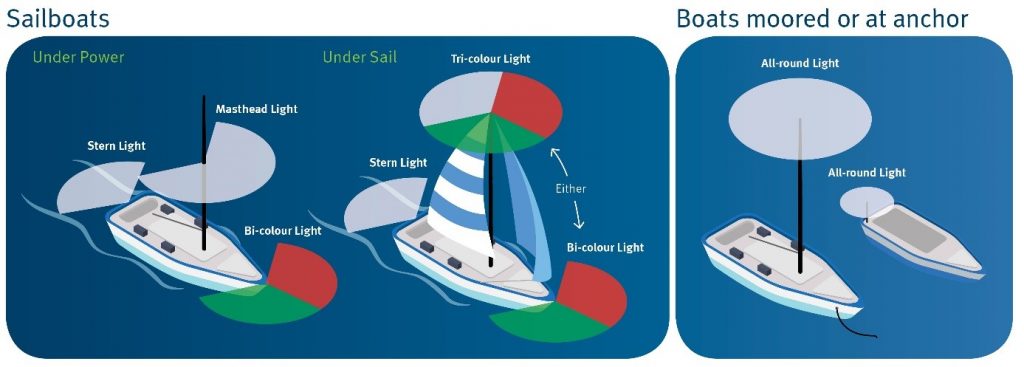
So what about interpreting these lights?
Having specific maximum angles on each light makes it possible to interpret the lights and draw some conclusions to avoid collisions. Let’s elaborate in detail what we can see and what it means to us looking at a similar yacht to ours…
When we encounter a light or lights like the ones below we can make deductions and use these deductions to make decisions that will keep us all safe. Let’s look at some really simple examples to get warmed up to the idea of interpreting lights on boats. Let’s start by interpreting how other boats would see our boat…
Samples of sailing vessels
- It is a sailing vessel
- The vessel is underway
- It is sailing or perhaps motoring
- We can only see the stern light so it must be travelling away from us.
- If it is not moving, it may be an anchored or moored vessel
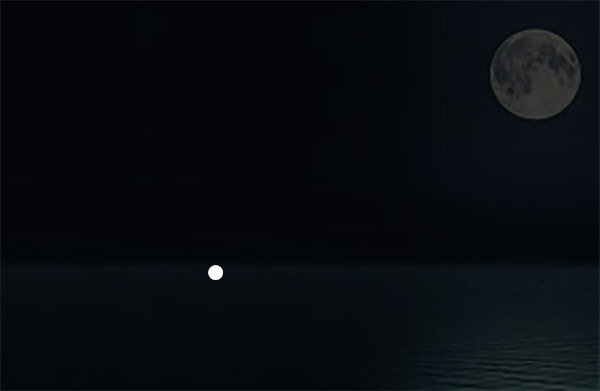
Rule 25 Sailing Vessels Underway and Vessels Under Oars
(a) a sailing vessel underway shall exhibit:
- (i) sidelights;
- (ii) a sternlight.
(b) In a sailing vessel of less than 20 meters in length the lights prescribed in paragraph (a) of this Rule may be combined in one lantern carried at or near the top of the mast where it can best be seen.
(c) A sailing vessel underway may, in addition to the lights prescribed in paragraph (a) of this Rule, exhibit at or near the top of the mast, where they can best be seen, two all-round lights in a vertical line, the upper being red and the lower Green, but these lights shall not be exhibited in conjunction with the combined lantern permitted by paragraph (b) of this Rule.
(d)
- (i) A sailing vessel of less than 7 meters in length shall, if practicable, exhibit the lights prescribed in paragraph (a) or (b) of this Rule, but if she does not, she shall have ready at hand an electric torch or lighted lantern showing a white light which shall be exhibited in sufficient time to prevent collision.
- (ii) A vessel under oars may exhibit the lights prescribed in this rule for sailing vessels, but if she does not, she shall have ready at hand an electric torch or lighted lantern showing a white light which shall be exhibited in sufficient time to prevent collision.
(e) A vessel proceeding under sail when also being propelled by machinery shall exhibit forward where it can best be seen a conical shape, apex downwards.
We know it is a sailboat under sail or perhaps motoring because we can only see one white light.
The fact is that we can only see the white light which we know is a stern light. Because none of the red or green sidelights are visible, we must assume that the vessel is moving directly away from us.
- It is a sailing vessel
- The vessel is underway
- It is sailing and not motoring
- We can only see the port and starboard sidelights so it must be travelling towards us.

Rule 25 Sailing Vessels Underway and Vessels Under Oars
(a) a sailing vessel underway shall exhibit:
- (i) sidelights;
- (ii) a sternlight.
(b) In a sailing vessel of less than 20 meters in length the lights prescribed in paragraph (a) of this Rule may be combined in one lantern carried at or near the top of the mast where it can best be seen.
(c) A sailing vessel underway may, in addition to the lights prescribed in paragraph (a) of this Rule, exhibit at or near the top of the mast, where they can best be seen, two all-round lights in a vertical line, the upper being red and the lower Green, but these lights shall not be exhibited in conjunction with the combined lantern permitted by paragraph (b) of this Rule.
(d)
- (i) A sailing vessel of less than 7 meters in length shall, if practicable, exhibit the lights prescribed in paragraph (a) or (b) of this Rule, but if she does not, she shall have ready at hand an electric torch or lighted lantern showing a white light which shall be exhibited in sufficient time to prevent collision.
- (ii) A vessel under oars may exhibit the lights prescribed in this rule for sailing vessels, but if she does not, she shall have ready at hand an electric torch or lighted lantern showing a white light which shall be exhibited in sufficient time to prevent collision.
(e) A vessel proceeding under sail when also being propelled by machinery shall exhibit forward where it can best be seen a conical shape, apex downwards.
Again, here we see immediately that this is a sailing vessel under sail because no masthead light can be seen.
We see a very different situation compared to the first example. Because we can only see the red and green sidelights and not the stern light, we can deduce that this vessel is coming directly towards us.
- It is a sailing vessel
- The vessel is underway
- It is sailing and not motoring
- We can only see the stern light and the starboard sidelights so it must be marginally travelling away from us moving left to right.
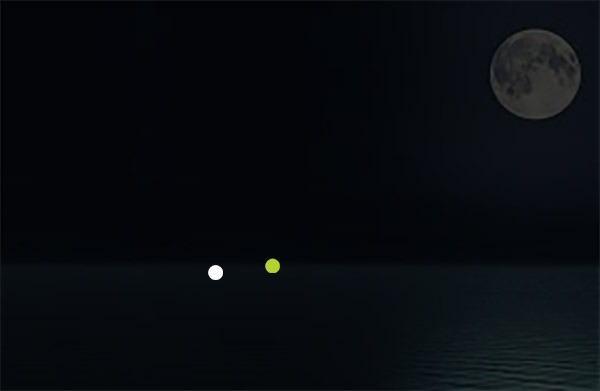
Rule 25 Sailing Vessels Underway and Vessels Under Oars
(a) a sailing vessel underway shall exhibit:
- (i) sidelights;
- (ii) a sternlight.
(b) In a sailing vessel of less than 20 meters in length the lights prescribed in paragraph (a) of this Rule may be combined in one lantern carried at or near the top of the mast where it can best be seen.
(c) A sailing vessel underway may, in addition to the lights prescribed in paragraph (a) of this Rule, exhibit at or near the top of the mast, where they can best be seen, two all-round lights in a vertical line, the upper being red and the lower Green, but these lights shall not be exhibited in conjunction with the combined lantern permitted by paragraph (b) of this Rule.
(d)
- (i) A sailing vessel of less than 7 meters in length shall, if practicable, exhibit the lights prescribed in paragraph (a) or (b) of this Rule, but if she does not, she shall have ready at hand an electric torch or lighted lantern showing a white light which shall be exhibited in sufficient time to prevent collision.
- (ii) A vessel under oars may exhibit the lights prescribed in this rule for sailing vessels, but if she does not, she shall have ready at hand an electric torch or lighted lantern showing a white light which shall be exhibited in sufficient time to prevent collision.
(e) A vessel proceeding under sail when also being propelled by machinery shall exhibit forward where it can best be seen a conical shape, apex downwards.
Again, here we see immediately that this is a sailing vessel under sail because no masthead light can be seen.
In this scenario, we see a stern light but also the green starboard sidelight. In order to see the green starboard sidelight and not the red, we can assume the vessel is side on to our position. Furthermore, we see the stern light which means that perhaps the vessel is also somewhat moving away from us. So we can conclude that the yacht is moving from left to right and away from us.
- It is a sailing vessel
- The vessel is underway
- It is sailing and not motoring
- We can only see the stern light and the port sidelights so it must be marginally travelling away from us moving right to left.
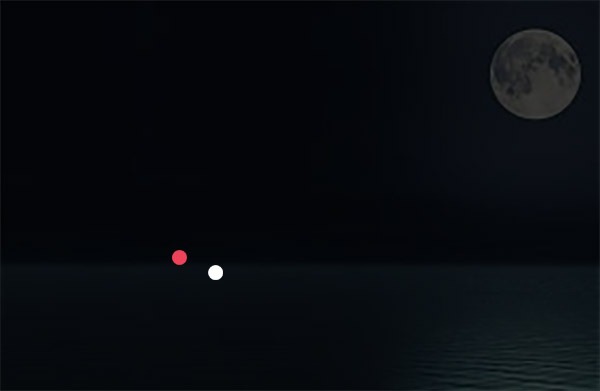
Rule 25 Sailing Vessels Underway and Vessels Under Oars
(a) a sailing vessel underway shall exhibit:
- (i) sidelights;
- (ii) a sternlight.
(b) In a sailing vessel of less than 20 meters in length the lights prescribed in paragraph (a) of this Rule may be combined in one lantern carried at or near the top of the mast where it can best be seen.
(c) A sailing vessel underway may, in addition to the lights prescribed in paragraph (a) of this Rule, exhibit at or near the top of the mast, where they can best be seen, two all-round lights in a vertical line, the upper being red and the lower Green, but these lights shall not be exhibited in conjunction with the combined lantern permitted by paragraph (b) of this Rule.
(d)
- (i) A sailing vessel of less than 7 meters in length shall, if practicable, exhibit the lights prescribed in paragraph (a) or (b) of this Rule, but if she does not, she shall have ready at hand an electric torch or lighted lantern showing a white light which shall be exhibited in sufficient time to prevent collision.
- (ii) A vessel under oars may exhibit the lights prescribed in this rule for sailing vessels, but if she does not, she shall have ready at hand an electric torch or lighted lantern showing a white light which shall be exhibited in sufficient time to prevent collision.
(e) A vessel proceeding under sail when also being propelled by machinery shall exhibit forward where it can best be seen a conical shape, apex downwards.
In terms of the vessel, same-same as above. It must be a yacht under sail.
In this scenario, however, we see a stern light but also the red port sidelight. In order to see the red port sidelight and not the green, we can assume the vessel is side on to our position. Furthermore, we see the stern light which means that perhaps the vessel is also moving somewhat away from us. So we can conclude that the yacht is moving from right to left and away from us.
- It is a sailing vessel
- The vessel is underway
- It is sailing and not motoring
- We can only see the port sidelights so it must be moving right to left.
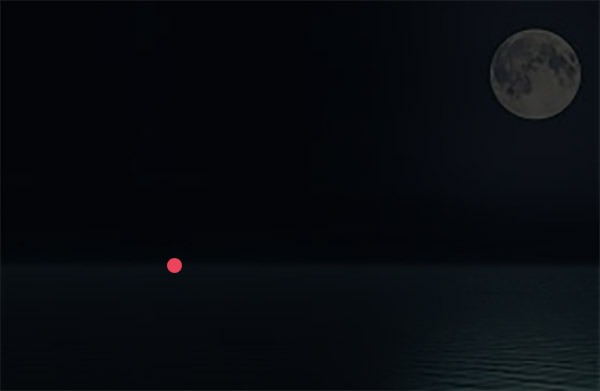
Rule 25 Sailing Vessels Underway and Vessels Under Oars
(a) a sailing vessel underway shall exhibit:
- (i) sidelights;
- (ii) a sternlight.
(b) In a sailing vessel of less than 20 meters in length the lights prescribed in paragraph (a) of this Rule may be combined in one lantern carried at or near the top of the mast where it can best be seen.
(c) A sailing vessel underway may, in addition to the lights prescribed in paragraph (a) of this Rule, exhibit at or near the top of the mast, where they can best be seen, two all-round lights in a vertical line, the upper being red and the lower Green, but these lights shall not be exhibited in conjunction with the combined lantern permitted by paragraph (b) of this Rule.
(d)
- (i) A sailing vessel of less than 7 meters in length shall, if practicable, exhibit the lights prescribed in paragraph (a) or (b) of this Rule, but if she does not, she shall have ready at hand an electric torch or lighted lantern showing a white light which shall be exhibited in sufficient time to prevent collision.
- (ii) A vessel under oars may exhibit the lights prescribed in this rule for sailing vessels, but if she does not, she shall have ready at hand an electric torch or lighted lantern showing a white light which shall be exhibited in sufficient time to prevent collision.
(e) A vessel proceeding under sail when also being propelled by machinery shall exhibit forward where it can best be seen a conical shape, apex downwards.
Now we can see the port sidelight. In order to see the red port sidelight and not the green, we can assume the vessel is side on to our position. Furthermore, we cannot see the stern light which means that perhaps the vessel is also moving somewhat towards us. So we can conclude that the yacht is moving from right to left and towards us.
- It is a sailing vessel
- The vessel is underway
- It is sailing and not motoring
- We can only see the starboard sidelights so it must be moving left to right.
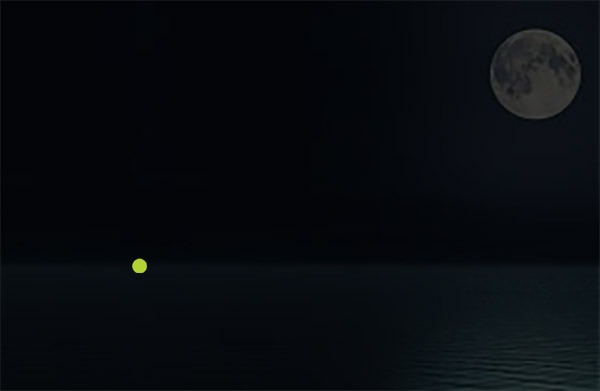
Rule 25 Sailing Vessels Underway and Vessels Under Oars
(a) a sailing vessel underway shall exhibit:
- (i) sidelights;
- (ii) a sternlight.
(b) In a sailing vessel of less than 20 meters in length the lights prescribed in paragraph (a) of this Rule may be combined in one lantern carried at or near the top of the mast where it can best be seen.
(c) A sailing vessel underway may, in addition to the lights prescribed in paragraph (a) of this Rule, exhibit at or near the top of the mast, where they can best be seen, two all-round lights in a vertical line, the upper being red and the lower Green, but these lights shall not be exhibited in conjunction with the combined lantern permitted by paragraph (b) of this Rule.
(d)
- (i) A sailing vessel of less than 7 meters in length shall, if practicable, exhibit the lights prescribed in paragraph (a) or (b) of this Rule, but if she does not, she shall have ready at hand an electric torch or lighted lantern showing a white light which shall be exhibited in sufficient time to prevent collision.
- (ii) A vessel under oars may exhibit the lights prescribed in this rule for sailing vessels, but if she does not, she shall have ready at hand an electric torch or lighted lantern showing a white light which shall be exhibited in sufficient time to prevent collision.
(e) A vessel proceeding under sail when also being propelled by machinery shall exhibit forward where it can best be seen a conical shape, apex downwards.
Here we see the opposite: the green starboard sidelight. In order to see the green starboard sidelight, we can assume the vessel is side on to our position. Furthermore, we cannot see the stern light which means that perhaps the vessel is also somewhat moving towards us. So we can conclude that the yacht is moving from left to right and towards us.
Because our yacht may be under motor, we can also look at the below to see how other boaters see our yacht at night. Although you are on a sailboat when motoring you are now classified as a powerboat but smaller than 50 meters and different rules apply.
- It is a sailing vessel under motor (or a power vessel)
- The vessel is underway
- It is motoring
- We can see both red and green sidelights as well as the masthead light.
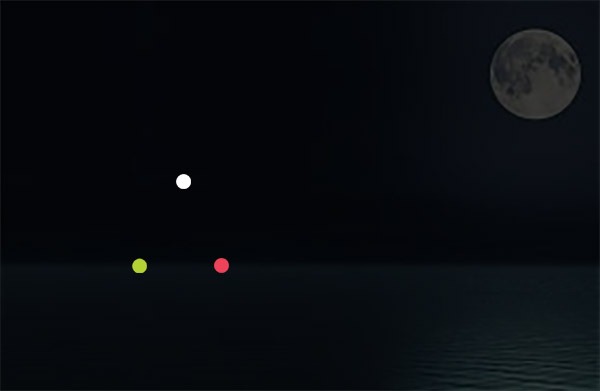
Rule 23 Power-driven Vessels Underway
(a)A power-driven vessel underway shall exhibit:
- (i) a masthead light forward;
- (ii) a second masthead light abaft of and higher than the forward one;
except that a vessel of less than 50 meters in length shall not be obliged to exhibit such a light but may do so; - (iii) sidelights: and
- (iv) a sternlight.
(b) An air-cushion vessel when operating in nondisplacement mode shall, in addition to the lights prescribed in paragraph (a) of this Rule, exhibit an all-round flashing yellow light.
(c) A WIG craft only when taking off, landing and in flight near the surface shall, in addition to the lights prescribed in paragraph (a) of this Rule, exhibit a high intensity all-round flashing red light.
(d)
- (i) A power-driven vessel of less than 12 meters in length may in lieu of the lights prescribed in paragraph (a) of this Rule exhibit an all-round white light and sidelights.
- (ii) a power-driven vessel of less than 7 meters in length whose maximum speed does not exceed 7 knots may in lieu of the lights prescribed in paragraph (a) of this Rule exhibit an all-round white light and shall, if practicable, also exhibit sidelights.
- (iii) the masthead light or all-round white light on a power-driven vessel of less than 12 meters in length may be displaced from the fore and aft centerline of the vessel if centerline fitting is not practicable, provided the sidelights are combined in one lantern which shall be carried on the fore and aft centerline of the vessel or located as nearly as practicable in the same fore and aft line as the masthead light or all-round white light.
Here we see a power vessel because we can see both the red and green sidelights as well as the masthead light. Remember, the masthead light is a 255 degree light facing forward so cannot be seen from behind. So because we can see the masthead light and the red and green sidelights, we can conclude it is a power vessel under 50 meters moving towards us.
So if we only had cruising yachts on the water then the above rules would have been sufficient. Naturally, there are many other vessels out there so let’s look at some of these next…
Let's have a look at at some other boats and situations
Naturally, there is more happening at night than just other yachts. However, now we covered the principles of what lights are required on our boat as well as recognising other yachts and interpreting their orientation and movement relevant to ours, we can have a look at other vessels such as power vessels, boats that tow things, fishing vessels and more.
Power vessels
- It is a power vessel
- It is smaller than 50 meters (<50m)
- The vessel is underway
- We can only see the masthead light and the green starboard sidelight so it must be predominantly moving left to right
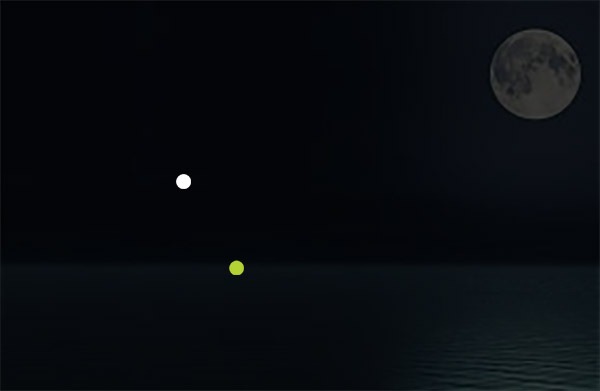
Rule 23 Power-driven Vessels Underway
(a)A power-driven vessel underway shall exhibit:
- (i) a masthead light forward;
- (ii) a second masthead light abaft of and higher than the forward one;
except that a vessel of less than 50 meters in length shall not be obliged to exhibit such a light but may do so; - (iii) sidelights: and
- (iv) a sternlight.
(b) An air-cushion vessel when operating in nondisplacement mode shall, in addition to the lights prescribed in paragraph (a) of this Rule, exhibit an all-round flashing yellow light.
(c) A WIG craft only when taking off, landing and in flight near the surface shall, in addition to the lights prescribed in paragraph (a) of this Rule, exhibit a high intensity all-round flashing red light.
(d)
- (i) A power-driven vessel of less than 12 meters in length may in lieu of the lights prescribed in paragraph (a) of this Rule exhibit an all-round white light and sidelights.
- (ii) a power-driven vessel of less than 7 meters in length whose maximum speed does not exceed 7 knots may in lieu of the lights prescribed in paragraph (a) of this Rule exhibit an all-round white light and shall, if practicable, also exhibit sidelights.
- (iii) the masthead light or all-round white light on a power-driven vessel of less than 12 meters in length may be displaced from the fore and aft centerline of the vessel if centerline fitting is not practicable, provided the sidelights are combined in one lantern which shall be carried on the fore and aft centerline of the vessel or located as nearly as practicable in the same fore and aft line as the masthead light or all-round white light.
Here we see perhaps a similar yacht like ours but let’s say a power vessel under 50 meters (<50m) because we can see the masthead light. The green starboard sidelight should tell us that we are looking at the vessel’s starboard side. Therefore we can conclude that the vessel is moving from left to right relevant to our position.
- It is a power vessel
- It is smaller than 50 meters (<50m) or larger than 50 meters (>50m)*
- The vessel is underway
- We can only see the masthead lights and the green starboard sidelight so it must be predominantly moving left to right
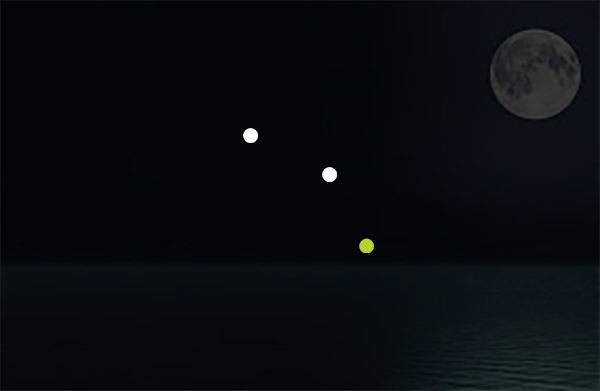
Rule 23 Power-driven Vessels Underway
(a)A power-driven vessel underway shall exhibit:
- (i) a masthead light forward;
- (ii) a second masthead light abaft of and higher than the forward one;
except that a vessel of less than 50 meters in length shall not be obliged to exhibit such a light but may do so; - (iii) sidelights: and
- (iv) a sternlight.
(b) An air-cushion vessel when operating in nondisplacement mode shall, in addition to the lights prescribed in paragraph (a) of this Rule, exhibit an all-round flashing yellow light.
(c) A WIG craft only when taking off, landing and in flight near the surface shall, in addition to the lights prescribed in paragraph (a) of this Rule, exhibit a high intensity all-round flashing red light.
(d)
- (i) A power-driven vessel of less than 12 meters in length may in lieu of the lights prescribed in paragraph (a) of this Rule exhibit an all-round white light and sidelights.
- (ii) a power-driven vessel of less than 7 meters in length whose maximum speed does not exceed 7 knots may in lieu of the lights prescribed in paragraph (a) of this Rule exhibit an all-round white light and shall, if practicable, also exhibit sidelights.
- (iii) the masthead light or all-round white light on a power-driven vessel of less than 12 meters in length may be displaced from the fore and aft centerline of the vessel if centerline fitting is not practicable, provided the sidelights are combined in one lantern which shall be carried on the fore and aft centerline of the vessel or located as nearly as practicable in the same fore and aft line as the masthead light or all-round white light.
The situation is similar to the previous example with one specific difference. Rule 23 (a)(ii) mandates a power vessel >50m to have a second masthead light abaft of and higher than the forward one. At the same time, this section also states that power vessels <50m may, although not compulsory, do the same. This means that it is impossible to distinguish between a power vessel <50m and a power vessel >50m. Ie, one masthead light = a power vessel <50m whereas two masthead lights = a power vessel >50m but perhaps also a power vessel <50m.
Vessels towing
Vessels may tow barges or other vessels such as a string of little reef boats. If a vessel has something in tow it must exhibit two additional requirements:
- A yellow “towing light” having the same characteristics as the “stern light” and placed in a vertical line above the stern light, and
- two masthead lights in a vertical line, or
- three masthead lights in a vertical line if the tow measures more than 200 meters
- It is a power vessel
- The vessel is underway
- We can only see the stern light and the tow light so the towing vessel is moving away from us.
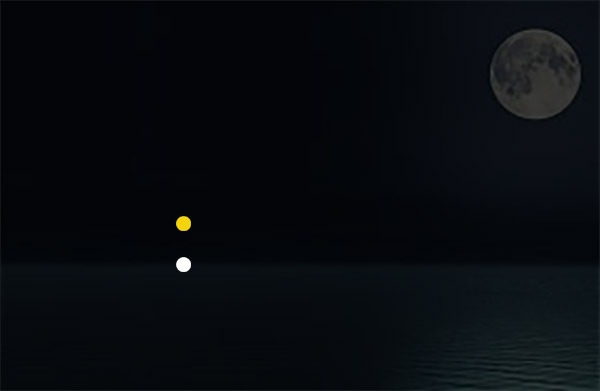
Rule 24 Towing and Pushing
(a) A power driven vessel when towing shall exhibit:
- (i) instead of the light prescribed in Rule 23(a)(i) or (a)(ii), two masthead lights in a vertical line. When the length of the tow measuring from the stern of the towing vessel to the after end of the tow exceeds 200 meters, three such lights in a vertical line;
- (ii) sidelights;
- (iii) a sternlight;
- (iv) a towing light in a vertical line above the sternlight;
and
- (v) when the length of the tow exceeds 200 meters, a diamond shape where it can best be seen.
(b) When a pushing vessel and a vessel being pushed ahead are rigidly connected in a composite unit they shall be regarded as a power-driven vessel and exhibit the lights prescribed in Rule 23.
(c) A power-driven vessel when pushing ahead or towing alongside, except in the case of a composite unit, shall exhibit:
- (i) instead of the light prescribed in Rule 23(a)(i) or (a)(ii), two masthead lights in a vertical line. When the length of the tow measuring from the stern of the towing vessel to the after end of the tow exceeds 200 meters, three such lights in a vertical line;
- (ii) sidelights;
- (iii) a sternlight.
(d) A power-driven vessel to which paragraph (a) or (c) of this Rule apply shall also comply with rule 23(a)(ii).
(e) A vessel or object being towed, other than those mentioned in paragraph (g) of this Rule, shall exhibit:
- (i) sidelights;
- (ii) a sternlight;
- (iii) when the length of the tow exceeds 200 meters, a diamond shape where it can best be seen.
(f) Provided that any number of vessels being towed alongside or pushed in a group shall be lighted as one vessel,
- (i) a vessel being pushed ahead, not being part of a composite unit, shall exhibit at the forward end, sidelights;
- (ii) a vessel being towed alongside shall exhibit a sternlight and at the forward end, sidelights.
(g) An inconspicuous, partly submerged vessel or object, or combination of such vessels or objects being towed, shall exhibit:
- (i) if it is less than 25 meters in breadth, one all-round white light at or near the front end and one at or near the after end except that dracones need not exhibit a light at or near the forward end;
- (ii) if it is 25 meters or more in breadth, two or more additional all-round white lights at or near the extremities of its breadth;
- (iii) if it exceeds 100 meters in length, additional all-round white lights between the lights prescribed in subparagraphs (i) and (ii) so that the distance between the lights shall not exceed 100 meters.;
- (iv) a diamond shape at or near the aftermost extremity of the last vessel or object being towed and if the length of the tow exceeds 200 meters an additional diamond shape where it can best be seen and located as far forward as is practicable.
(h) When from any sufficient cause it is impracticable for a vessel or object being towed to exhibit the lights or shapes prescribed in paragraph (e) or (g) of this Rule, all possible measures shall be taken to light the vessel or object being towed or at least indicate the presence of such vessel or object.
(i) Where from any sufficient cause it is impracticable for a vessel not normally engaged in towing operations to display the lights prescribed in paragraph (a) or (c) of this Rule, such vessel shall not be required to exhibit those lights when engaged in towing another vessel in distress or otherwise in need of assistance. All possible measures shall be taken to indicate the nature of the relationship between the towing vessel and the vessel being towed as authorized by Rule 36, in particular by illuminating the towline.
Here we can see the yellow tow light indicating that we are looking at a power-driven vessel underway. Naturally, you need to pay extra attention to a vessel towing (or pushing) something because its size is now the vessel itself plus the tow. There are a couple of bits of intelligence we get from a towing light in combination with the masthead light(s).
- The size of the vessel – smaller than 50 meters (<50) or larger than 50 meters (>50m), and
- The size of the tow – smaller than 200 meters (<200) or larger than 200 meters (>200m).
Let’s have a look at what we are talking about below.
- It is a power vessel <50 meters
- The vessel is underway
- It is towing something < 200 meters long
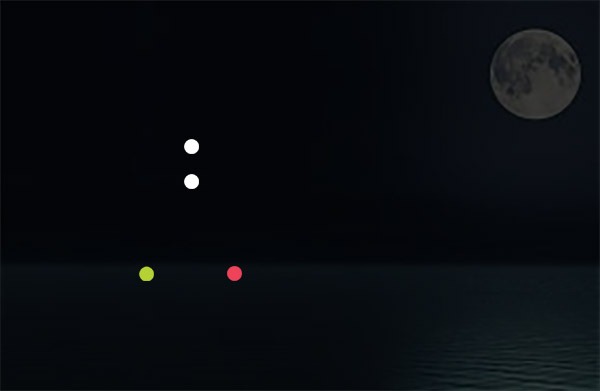
Rule 24 Towing and Pushing
(a) A power driven vessel when towing shall exhibit:
- (i) instead of the light prescribed in Rule 23(a)(i) or (a)(ii), two masthead lights in a vertical line. When the length of the tow measuring from the stern of the towing vessel to the after end of the tow exceeds 200 meters, three such lights in a vertical line;
- (ii) sidelights;
- (iii) a sternlight;
- (iv) a towing light in a vertical line above the sternlight;
and
- (v) when the length of the tow exceeds 200 meters, a diamond shape where it can best be seen.
(b) When a pushing vessel and a vessel being pushed ahead are rigidly connected in a composite unit they shall be regarded as a power-driven vessel and exhibit the lights prescribed in Rule 23.
(c) A power-driven vessel when pushing ahead or towing alongside, except in the case of a composite unit, shall exhibit:
- (i) instead of the light prescribed in Rule 23(a)(i) or (a)(ii), two masthead lights in a vertical line. When the length of the tow measuring from the stern of the towing vessel to the after end of the tow exceeds 200 meters, three such lights in a vertical line;
- (ii) sidelights;
- (iii) a sternlight.
(d) A power-driven vessel to which paragraph (a) or (c) of this Rule apply shall also comply with rule 23(a)(ii).
(e) A vessel or object being towed, other than those mentioned in paragraph (g) of this Rule, shall exhibit:
- (i) sidelights;
- (ii) a sternlight;
- (iii) when the length of the tow exceeds 200 meters, a diamond shape where it can best be seen.
(f) Provided that any number of vessels being towed alongside or pushed in a group shall be lighted as one vessel,
- (i) a vessel being pushed ahead, not being part of a composite unit, shall exhibit at the forward end, sidelights;
- (ii) a vessel being towed alongside shall exhibit a sternlight and at the forward end, sidelights.
(g) An inconspicuous, partly submerged vessel or object, or combination of such vessels or objects being towed, shall exhibit:
- (i) if it is less than 25 meters in breadth, one all-round white light at or near the front end and one at or near the after end except that dracones need not exhibit a light at or near the forward end;
- (ii) if it is 25 meters or more in breadth, two or more additional all-round white lights at or near the extremities of its breadth;
- (iii) if it exceeds 100 meters in length, additional all-round white lights between the lights prescribed in subparagraphs (i) and (ii) so that the distance between the lights shall not exceed 100 meters.;
- (iv) a diamond shape at or near the aftermost extremity of the last vessel or object being towed and if the length of the tow exceeds 200 meters an additional diamond shape where it can best be seen and located as far forward as is practicable.
(h) When from any sufficient cause it is impracticable for a vessel or object being towed to exhibit the lights or shapes prescribed in paragraph (e) or (g) of this Rule, all possible measures shall be taken to light the vessel or object being towed or at least indicate the presence of such vessel or object.
(i) Where from any sufficient cause it is impracticable for a vessel not normally engaged in towing operations to display the lights prescribed in paragraph (a) or (c) of this Rule, such vessel shall not be required to exhibit those lights when engaged in towing another vessel in distress or otherwise in need of assistance. All possible measures shall be taken to indicate the nature of the relationship between the towing vessel and the vessel being towed as authorized by Rule 36, in particular by illuminating the towline.
Above we can see a vessel smaller than 50 meters towing something that is smaller than 200 meters. By now we know that due to the visibility of the green and red sidelights that the vessel is coming towards us.
Note that we are assuming a lot here. It could be a power vessel <50m with an additional masthead so just indicating the size and not towing anything. It could also be a power vessel >50m indicating just it’s size without anything in tow. We need to have a more sideways look to pick up the masthead lights to make a more informed appreciation of the situation.
- It is a power vessel <50 meters
- The vessel is underway
- It is towing something < 200 meters long
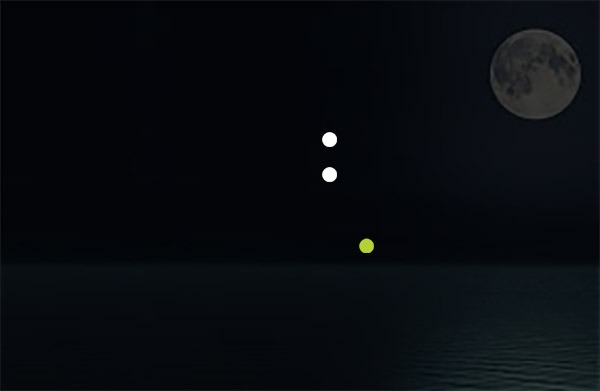
Rule 24 Towing and Pushing
(a) A power driven vessel when towing shall exhibit:
- (i) instead of the light prescribed in Rule 23(a)(i) or (a)(ii), two masthead lights in a vertical line. When the length of the tow measuring from the stern of the towing vessel to the after end of the tow exceeds 200 meters, three such lights in a vertical line;
- (ii) sidelights;
- (iii) a sternlight;
- (iv) a towing light in a vertical line above the sternlight;
and
- (v) when the length of the tow exceeds 200 meters, a diamond shape where it can best be seen.
(b) When a pushing vessel and a vessel being pushed ahead are rigidly connected in a composite unit they shall be regarded as a power-driven vessel and exhibit the lights prescribed in Rule 23.
(c) A power-driven vessel when pushing ahead or towing alongside, except in the case of a composite unit, shall exhibit:
- (i) instead of the light prescribed in Rule 23(a)(i) or (a)(ii), two masthead lights in a vertical line. When the length of the tow measuring from the stern of the towing vessel to the after end of the tow exceeds 200 meters, three such lights in a vertical line;
- (ii) sidelights;
- (iii) a sternlight.
(d) A power-driven vessel to which paragraph (a) or (c) of this Rule apply shall also comply with rule 23(a)(ii).
(e) A vessel or object being towed, other than those mentioned in paragraph (g) of this Rule, shall exhibit:
- (i) sidelights;
- (ii) a sternlight;
- (iii) when the length of the tow exceeds 200 meters, a diamond shape where it can best be seen.
(f) Provided that any number of vessels being towed alongside or pushed in a group shall be lighted as one vessel,
- (i) a vessel being pushed ahead, not being part of a composite unit, shall exhibit at the forward end, sidelights;
- (ii) a vessel being towed alongside shall exhibit a sternlight and at the forward end, sidelights.
(g) An inconspicuous, partly submerged vessel or object, or combination of such vessels or objects being towed, shall exhibit:
- (i) if it is less than 25 meters in breadth, one all-round white light at or near the front end and one at or near the after end except that dracones need not exhibit a light at or near the forward end;
- (ii) if it is 25 meters or more in breadth, two or more additional all-round white lights at or near the extremities of its breadth;
- (iii) if it exceeds 100 meters in length, additional all-round white lights between the lights prescribed in subparagraphs (i) and (ii) so that the distance between the lights shall not exceed 100 meters.;
- (iv) a diamond shape at or near the aftermost extremity of the last vessel or object being towed and if the length of the tow exceeds 200 meters an additional diamond shape where it can best be seen and located as far forward as is practicable.
(h) When from any sufficient cause it is impracticable for a vessel or object being towed to exhibit the lights or shapes prescribed in paragraph (e) or (g) of this Rule, all possible measures shall be taken to light the vessel or object being towed or at least indicate the presence of such vessel or object.
(i) Where from any sufficient cause it is impracticable for a vessel not normally engaged in towing operations to display the lights prescribed in paragraph (a) or (c) of this Rule, such vessel shall not be required to exhibit those lights when engaged in towing another vessel in distress or otherwise in need of assistance. All possible measures shall be taken to indicate the nature of the relationship between the towing vessel and the vessel being towed as authorized by Rule 36, in particular by illuminating the towline.
Now we can see more and hence can have a better appreciation of what we are looking at. We can see a power vessel smaller than 50 meters towing something that is smaller than 200 meters. We know this because there are 2 masthead lights vertically aligned (vertically means “towing”) and there is no other masthead light abaft and higher (which means “size”). Because of the green starboard sidelight, we know that the vessel is travelling from left to right. Note that the bulk of the vessel could well be behind it so pay extra attention not to sail between the vessel and its tow.
- It is a power vessel <50 meters
- The vessel is underway
- It is towing something >200 meters long

Rule 24 Towing and Pushing
(a) A power driven vessel when towing shall exhibit:
- (i) instead of the light prescribed in Rule 23(a)(i) or (a)(ii), two masthead lights in a vertical line. When the length of the tow measuring from the stern of the towing vessel to the after end of the tow exceeds 200 meters, three such lights in a vertical line;
- (ii) sidelights;
- (iii) a sternlight;
- (iv) a towing light in a vertical line above the sternlight;
and
- (v) when the length of the tow exceeds 200 meters, a diamond shape where it can best be seen.
(b) When a pushing vessel and a vessel being pushed ahead are rigidly connected in a composite unit they shall be regarded as a power-driven vessel and exhibit the lights prescribed in Rule 23.
(c) A power-driven vessel when pushing ahead or towing alongside, except in the case of a composite unit, shall exhibit:
- (i) instead of the light prescribed in Rule 23(a)(i) or (a)(ii), two masthead lights in a vertical line. When the length of the tow measuring from the stern of the towing vessel to the after end of the tow exceeds 200 meters, three such lights in a vertical line;
- (ii) sidelights;
- (iii) a sternlight.
(d) A power-driven vessel to which paragraph (a) or (c) of this Rule apply shall also comply with rule 23(a)(ii).
(e) A vessel or object being towed, other than those mentioned in paragraph (g) of this Rule, shall exhibit:
- (i) sidelights;
- (ii) a sternlight;
- (iii) when the length of the tow exceeds 200 meters, a diamond shape where it can best be seen.
(f) Provided that any number of vessels being towed alongside or pushed in a group shall be lighted as one vessel,
- (i) a vessel being pushed ahead, not being part of a composite unit, shall exhibit at the forward end, sidelights;
- (ii) a vessel being towed alongside shall exhibit a sternlight and at the forward end, sidelights.
(g) An inconspicuous, partly submerged vessel or object, or combination of such vessels or objects being towed, shall exhibit:
- (i) if it is less than 25 meters in breadth, one all-round white light at or near the front end and one at or near the after end except that dracones need not exhibit a light at or near the forward end;
- (ii) if it is 25 meters or more in breadth, two or more additional all-round white lights at or near the extremities of its breadth;
- (iii) if it exceeds 100 meters in length, additional all-round white lights between the lights prescribed in subparagraphs (i) and (ii) so that the distance between the lights shall not exceed 100 meters.;
- (iv) a diamond shape at or near the aftermost extremity of the last vessel or object being towed and if the length of the tow exceeds 200 meters an additional diamond shape where it can best be seen and located as far forward as is practicable.
(h) When from any sufficient cause it is impracticable for a vessel or object being towed to exhibit the lights or shapes prescribed in paragraph (e) or (g) of this Rule, all possible measures shall be taken to light the vessel or object being towed or at least indicate the presence of such vessel or object.
(i) Where from any sufficient cause it is impracticable for a vessel not normally engaged in towing operations to display the lights prescribed in paragraph (a) or (c) of this Rule, such vessel shall not be required to exhibit those lights when engaged in towing another vessel in distress or otherwise in need of assistance. All possible measures shall be taken to indicate the nature of the relationship between the towing vessel and the vessel being towed as authorized by Rule 36, in particular by illuminating the towline.
The only difference in this example is the fact that the vessel has three masthead lights vertically positioned denoting a power vessel <50m towing >200m.
- It is a power vessel >50 meters
- The vessel is underway
- It is towing something >200 meters long

Rule 24 Towing and Pushing
(a) A power driven vessel when towing shall exhibit:
- (i) instead of the light prescribed in Rule 23(a)(i) or (a)(ii), two masthead lights in a vertical line. When the length of the tow measuring from the stern of the towing vessel to the after end of the tow exceeds 200 meters, three such lights in a vertical line;
- (ii) sidelights;
- (iii) a sternlight;
- (iv) a towing light in a vertical line above the sternlight;
and
- (v) when the length of the tow exceeds 200 meters, a diamond shape where it can best be seen.
(b) When a pushing vessel and a vessel being pushed ahead are rigidly connected in a composite unit they shall be regarded as a power-driven vessel and exhibit the lights prescribed in Rule 23.
(c) A power-driven vessel when pushing ahead or towing alongside, except in the case of a composite unit, shall exhibit:
- (i) instead of the light prescribed in Rule 23(a)(i) or (a)(ii), two masthead lights in a vertical line. When the length of the tow measuring from the stern of the towing vessel to the after end of the tow exceeds 200 meters, three such lights in a vertical line;
- (ii) sidelights;
- (iii) a sternlight.
(d) A power-driven vessel to which paragraph (a) or (c) of this Rule apply shall also comply with rule 23(a)(ii).
(e) A vessel or object being towed, other than those mentioned in paragraph (g) of this Rule, shall exhibit:
- (i) sidelights;
- (ii) a sternlight;
- (iii) when the length of the tow exceeds 200 meters, a diamond shape where it can best be seen.
(f) Provided that any number of vessels being towed alongside or pushed in a group shall be lighted as one vessel,
- (i) a vessel being pushed ahead, not being part of a composite unit, shall exhibit at the forward end, sidelights;
- (ii) a vessel being towed alongside shall exhibit a sternlight and at the forward end, sidelights.
(g) An inconspicuous, partly submerged vessel or object, or combination of such vessels or objects being towed, shall exhibit:
- (i) if it is less than 25 meters in breadth, one all-round white light at or near the front end and one at or near the after end except that dracones need not exhibit a light at or near the forward end;
- (ii) if it is 25 meters or more in breadth, two or more additional all-round white lights at or near the extremities of its breadth;
- (iii) if it exceeds 100 meters in length, additional all-round white lights between the lights prescribed in subparagraphs (i) and (ii) so that the distance between the lights shall not exceed 100 meters.;
- (iv) a diamond shape at or near the aftermost extremity of the last vessel or object being towed and if the length of the tow exceeds 200 meters an additional diamond shape where it can best be seen and located as far forward as is practicable.
(h) When from any sufficient cause it is impracticable for a vessel or object being towed to exhibit the lights or shapes prescribed in paragraph (e) or (g) of this Rule, all possible measures shall be taken to light the vessel or object being towed or at least indicate the presence of such vessel or object.
(i) Where from any sufficient cause it is impracticable for a vessel not normally engaged in towing operations to display the lights prescribed in paragraph (a) or (c) of this Rule, such vessel shall not be required to exhibit those lights when engaged in towing another vessel in distress or otherwise in need of assistance. All possible measures shall be taken to indicate the nature of the relationship between the towing vessel and the vessel being towed as authorized by Rule 36, in particular by illuminating the towline.
The last variant of this situation is where we have a power vessel >50m towing something >200m. But note again that the abaft masthead light may be exhibited by a power vessel underway which is smaller than 50 meters.
Fishing vessels
Fishing vessels are a bit of a breed on their own. They are manned by professionals that expect others to know the rules. When fishing, these vessels become less manoeuvrable and therefore have the right-of-way. My advice is to stay clear of them in any situation even if you have the right-of-way irrespective of any rules under “The Merchant Shipping (Distress Signals and Prevention of Collisions) Regulations 1996″.
Saying this, fishing vessels are usually lit up like Christmas trees with deck lights seemingly powerful enough to light up half an ocean. Nonetheless, they are operating under Rule 26 and therefore must exhibit certain marine lights.
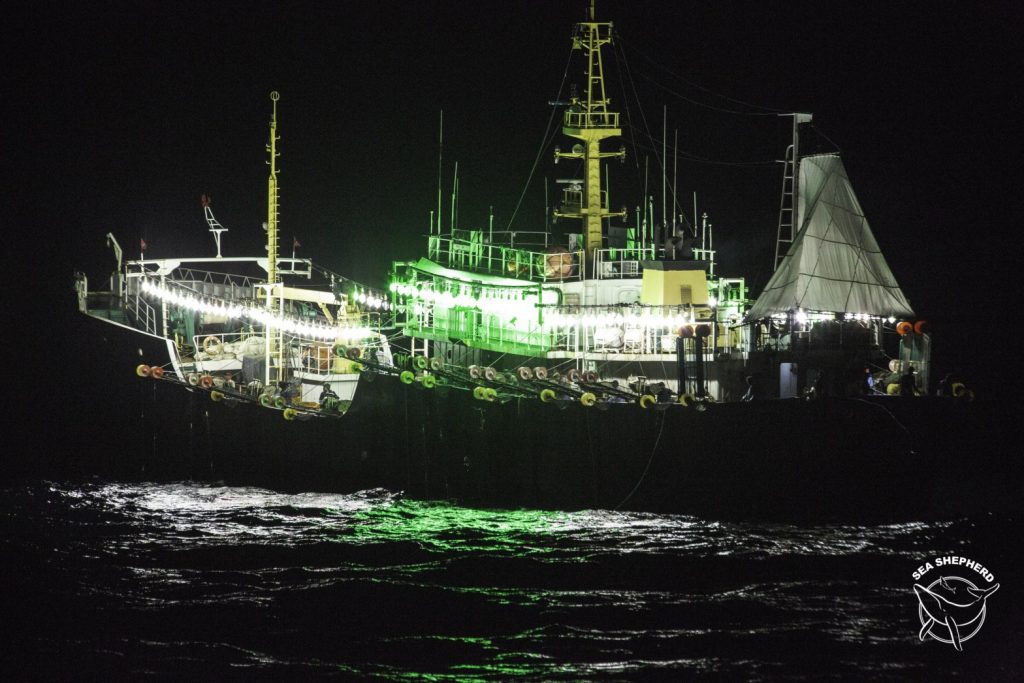
- It is a power vessel >50 meters
- The vessel is underway
- It is a fishing vessel
- It is conducting fishing activities
- It is not trawling
- To the left it is an aft view
- To the right is is a forward view
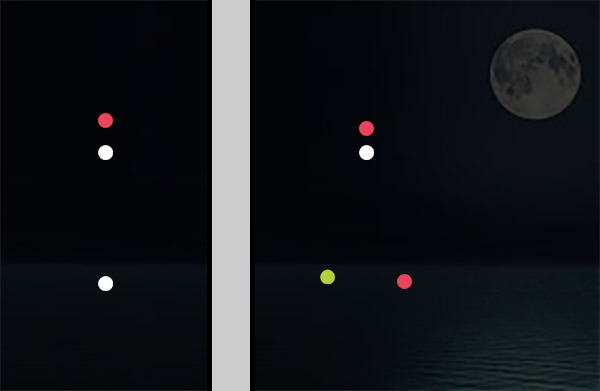
Rule 26 Fishing Vessels
(a) A vessel engaged in fishing, whether underway or at anchor, shall exhibit only the lights and shapes prescribed by this rule.
(b) A vessel when engaged in trawling, by which is meant the dragging through the water of a dredge net or other apparatus used as a fishing appliance, shall exhibit;
- (i) two all-round lights in a vertical line, the upper being green and the lower white, or a shape consisting of two cones with their apexes together in a vertical line one above the other; a vessel of less than 20 meters in length may instead of this shape exhibit a basket;
- (ii) a masthead light abaft of and higher than the all-round green light; a vessel of less than 50 meters in length shall not be obliged to exhibit such a light but may do so;
- (iii) when making way through the water, in addition to the lights prescribed in this paragraph, sidelights and a sternlight.
(c) A vessel engaged in fishing, other than trawling, shall exhibit:
- (i) two all-round lights in a vertical line, the upper being red and the lower white, or a shape consisting of two cones with their apexes together in a vertical line one above the other; a vessel of less than 20 meters in length may instead of this shape exhibit a basket;
- (ii)when there is outlying gear extending more than 150 meters horizontally from the vessel, an all-round white light or a cone apex upwards in the direction of the gear.
- (iii) when making way through the water, in addition to the lights prescribed in this paragraph, sidelights and a sternlight.
(d) A vessel engaged in fishing in close proximity to other vessels engaged in fishing may exhibit the additional signals described in Annex II to these Regulations.
(e) A vessel when not engaged in fishing shall not exhibit the lights or shapes prescribed in this Rule, but only those prescribed for a vessel of her length.
Okay, so let’s unpack that a little. Among other things, Rule 26(c)(i) mandates for a fishing vessel engaged in fishing (but not trawling) to exhibit two all-round lights in a vertical line, the upper being red and the lower white.
A small variant is when the fishing vessel is trawling. In this case, the red all-round light must be replaced by a green all-round light as stipulated by Rule 26(b)(i).
- It is a power vessel >50 meters
- The vessel is underway
- It is a fishing vessel
- It is conducting fishing activities
- It is trawling
- To the left it is an aft view
- To the right is is a forward view
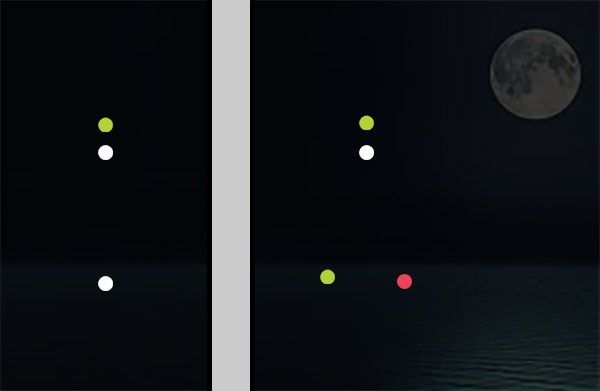
Rule 26 Fishing Vessels
(a) A vessel engaged in fishing, whether underway or at anchor, shall exhibit only the lights and shapes prescribed by this rule.
(b) A vessel when engaged in trawling, by which is meant the dragging through the water of a dredge net or other apparatus used as a fishing appliance, shall exhibit;
- (i) two all-round lights in a vertical line, the upper being green and the lower white, or a shape consisting of two cones with their apexes together in a vertical line one above the other; a vessel of less than 20 meters in length may instead of this shape exhibit a basket;
- (ii) a masthead light abaft of and higher than the all-round green light; a vessel of less than 50 meters in length shall not be obliged to exhibit such a light but may do so;
- (iii) when making way through the water, in addition to the lights prescribed in this paragraph, sidelights and a sternlight.
(c) A vessel engaged in fishing, other than trawling, shall exhibit:
- (i) two all-round lights in a vertical line, the upper being red and the lower white, or a shape consisting of two cones with their apexes together in a vertical line one above the other; a vessel of less than 20 meters in length may instead of this shape exhibit a basket;
- (ii)when there is outlying gear extending more than 150 meters horizontally from the vessel, an all-round white light or a cone apex upwards in the direction of the gear.
- (iii) when making way through the water, in addition to the lights prescribed in this paragraph, sidelights and a sternlight.
(d) A vessel engaged in fishing in close proximity to other vessels engaged in fishing may exhibit the additional signals described in Annex II to these Regulations.
(e) A vessel when not engaged in fishing shall not exhibit the lights or shapes prescribed in this Rule, but only those prescribed for a vessel of her length.
We can see that all other aspects of the previous situation are the same except that this fishing vessel is trawling
A vessel engaged in pilotage duties
Something that can be easily confused is observing a vessel engaged in pilotage duties as it looks very similar to a fishing vessel trawling. The only difference is the red and white lights are reversed, that is, white on top of red.
- It is a power vessel >50 meters
- The vessel is underway
- It is a fishing vessel
- It is conducting fishing activities
- It is trawling
- To the left it is an aft view
- To the right is is a forward view
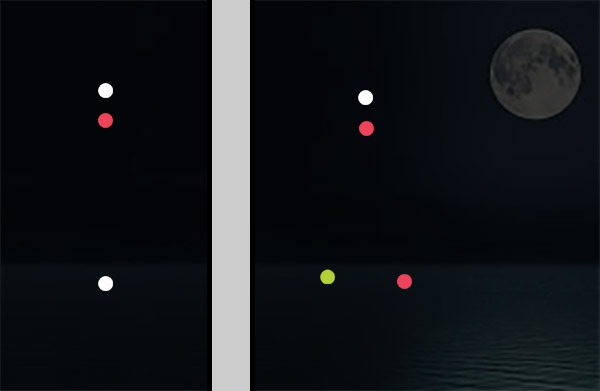
Rule 29 Pilot Vessels
(a) A vessel engaged on pilotage duty shall exhibit:
- (i) at or near the masthead, two all-round lights in a vertical line, the upper being white and the lower red;
- (ii) when underway, in addition, sidelights and a sternlight;
- (iii) when at anchor, in addition to the lights prescribed in subparagraph (i), the light, lights, or shape prescribed in Rule 30 for vessels at anchor.
(b) A pilot vessel when not engaged on pilotage duty shall exhibit the lights or shapes prescribed for a similar vessel of her length.
If you find any inaccuracies among these guidelines then please let me know by leaving a comment below. Or just voice your experience with marine lights or even just say hello…
